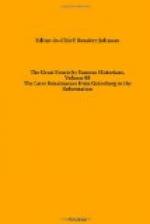After this period, Faust, and his son-in-law, Peter Schoeffer, in possession of the materials, printed on their own account, and, within eighteen months of their separation from Gutenberg, produced the celebrated Latin Psalter of 1457, the first book in any country which bears a complete imprint—that is, the name of the printer, place, and date. This magnificent volume, of which the whole edition was printed on vellum, is now even rarer than the Mazarin Bible, and of extraordinary value; the letters are very large and bold, cast in metal type, and the ornamental initials are beautifully cut in wood.
Two years later, that is, in 1459, Faust and Schoeffer produced an almost fac-simile reprint of the Psalter, and in the same year Durandi Rationale Divinorum Officiorum, the latter with an entirely new font of metal type—the first cast from Schoeffer’s punches—which some, in the erroneous belief that the Psalter was printed from wooden types, have asserted to be the first dated book printed with metal type. Then followed, in 1460, the Constitutiones Clementis V, a handsome folio, and in 1462 their famous Latin Bible, the first one with a date.
In the mean time, Gutenberg, undaunted by the loss of all that had cost him so many years of unremitted application and his whole fortune, began afresh; and this time, it should seem, with better success, as we find him, in 1459, undertaking to present, for certain considerations, all the books he had then printed, or might thereafter print, to a convent where his sister was a nun. No book, however, has yet been discovered bearing the name of Gutenberg; and we can only guess what came from his press by a peculiarity of type, of which, after the first Bible, the most marked is the famous Catholicon, dated 1460—a kind of universal dictionary, the germ of all future cyclopaedias, and which became so popular that more than forty editions were printed of it in as many years. In 1465 Gutenberg retired from printing, being appointed to a lucrative office at the court of the Archbishop of Mainz, and in 1467 he died.
And here we take leave of Gutenberg, with admiration for his patience, his perseverance, and his self-sacrifice in a cause which has produced such glorious fruits. He was one of those noble spirits who are endowed with a perception of what is good, and pursue it independent of worldly considerations. Posterity has done him tardy justice in erecting a marble monument to his memory and establishing a jubilee, which gave rise to one of the most touching of Mendelssohn’s compositions.
By this time the secret had transpired to the neighboring states, and Mentelin, of Strasburg, and Pfister, or Bamberg, were, before the beginning of 1462, in full activity. Indeed, Pfister is, by some, thought to have printed before 1460; and his finely executed Latin Bible, in cast type, was for many years regarded as the first.




